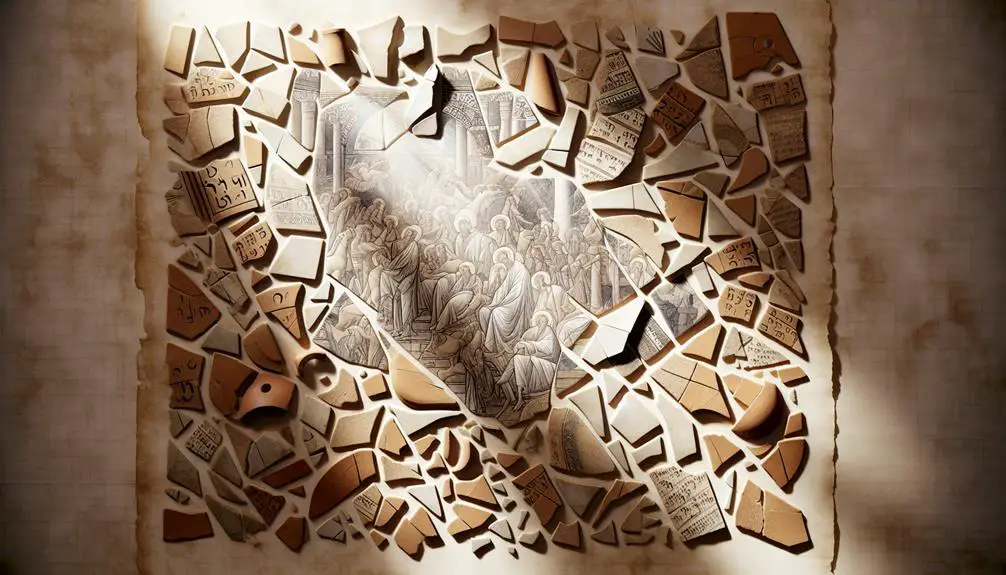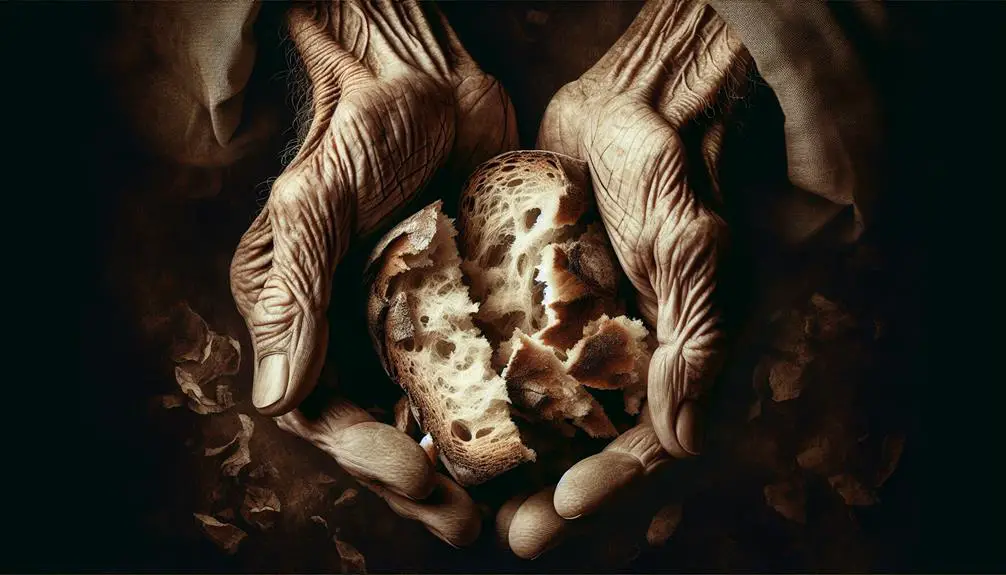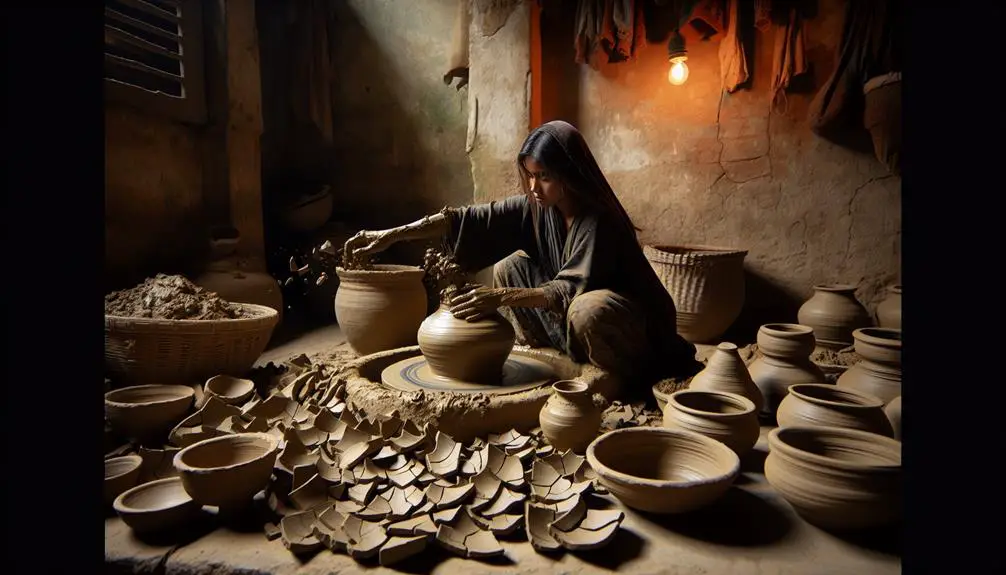Gain insight into how brokenness in biblical narratives symbolizes restoration and faith, revealing beauty in the shattered remains of ancient stories.

Broken Pieces in the Bible
As you walk through the tapestry of biblical narratives, you'll find that broken pieces aren't merely scattered artifacts of the past; they're central to the story's unfolding. From the shattered tablets of the Ten Commandments to the torn veil in the temple, brokenness serves as a powerful motif. It speaks to moments of covenant, sacrifice, and renewal.
Consider how Peter's denial, symbolizing broken loyalty, and the breaking of bread, denoting a new covenant, weave into this theme. What might these fragmented elements reveal about restoration and faith? Unpack this puzzle, and you might find the beauty in the brokenness.
Key Takeaways
- Brokenness in the Bible symbolizes both human frailty and opportunities for divine renewal.
- Divine intervention transforms broken pieces into symbols of new covenants and access to God.
- The act of breaking bread signifies spiritual unity and provision within the Christian community.
- The narratives of brokenness highlight the complex interplay between divine sovereignty and human responsibility.
The Shattered Tablets

Upon descending from Mount Sinai, Moses encountered the idolatrous revelry of the Israelites and, in a profound act of dismay, shattered the tablets bearing the Ten Commandments. This moment isn't merely a dramatic display of anger; it symbolizes a significant theological turning point, highlighting the fragility of the covenant between God and His people. You might view this act as a rupture in the divine-human relationship, necessitating divine intervention for covenant renewal.
The shattering of the tablets represents a dual reality of divine disappointment and the enduring hope for reconciliation. While the breaking of the tablets signifies a breach in the covenant caused by the Israelites' unfaithfulness, it also sets the stage for divine intervention and the possibility of covenant renewal. This event underscores a profound theological truth: despite human failings, God remains committed to His covenant with His people.
The narrative later recounts how Moses, following divine instructions, hews new tablets, which signifies the renewal of the covenant. This act of creating new tablets, following divine command, illustrates a pivotal moment of reconciliation and reaffirms God's enduring mercy and willingness to renew His covenant with His people, despite their transgressions.
Analyzing this episode, you see a powerful example of how divine intervention plays a crucial role in covenant renewal, offering a pathway back to a reconciled relationship with God. The shattered tablets, therefore, aren't just a symbol of judgment but also a beacon of hope, signaling the possibility of restoration and renewal even after profound failure.
The Torn Veil

ARTICLE TITLE: Broken Pieces in the Bible
PREVIOUS SUBTOPIC: 'The Shattered Tablets'
CURRENT SUBTOPIC: 'The Torn Veil'
Similarly, the tearing of the veil in the Temple at the moment of Jesus' crucifixion marks another profound theological shift, reflecting the opening of a direct path to God for believers. This event is loaded with Temple symbolism and signifies Divine access previously restricted. The veil, a heavy curtain separating the Holy of Holies, where God's presence was believed to dwell, from the rest of the Temple, symbolized the separation between God and humanity due to sin. Its tearing, from top to bottom, illustrates that this barrier has been removed through Jesus' sacrifice, granting believers direct access to God.
Before the Tearing |
After the Tearing |
|---|---|
Restricted Access |
Open Access |
Symbol of Separation |
Symbol of Unity |
Divine Distance |
Divine Proximity |
This act of the veil tearing is a pivotal moment in Christian theology. It not only signifies the fulfillment of Old Testament prophecies and ceremonies but also ushers in a new covenant between God and humanity. The event is rich with implications, suggesting that the rituals and sacrifices of the Temple are no longer necessary for atonement and communion with God. Instead, believers are invited to approach God directly, with Jesus acting as the mediator. The tearing of the veil is a powerful symbol of the new, open relationship between the Divine and humanity, emphasizing that Divine access is no longer limited by ceremonial law but is available to all through faith in Jesus Christ.
The Broken Bread

Reflecting on the Last Supper, the breaking of bread by Jesus embodies a significant theological pivot, symbolizing the establishment of a new covenant through His body given for humanity. This act serves as the foundation for communion symbolism, a ritual that resonates deeply within the Christian faith. It's not merely a reflection of Jesus' sacrifice but also an invitation for believers to partake in the divine, to remember, and to be renewed in faith and commitment.
The act of breaking bread, moreover, isn't isolated to the Last Supper. Jesus' ministry is punctuated with moments of feeding multitudes, where the breaking of bread serves as a prelude to miracles. These instances aren't just about physical nourishment but underscore a deeper spiritual provision. They reflect Jesus' role as the sustainer and his message of abundance in God's kingdom. The multiplication of loaves, for instance, illustrates God's boundless generosity and care, reinforcing the idea that in God, spiritual hunger is satiated, and every need is met.
In analyzing the broken bread, one encounters a rich tapestry of meanings and symbolism. It's a narrative thread that weaves through the gospels, binding the message of Jesus' life, death, and resurrection with the ongoing life of the Christian community. Through communion, believers across generations and geographies participate in this profound mystery, embodying the unity and continuity of the church. The broken bread, thus, isn't a symbol of fragmentation but of unity, sacrifice, and the promise of spiritual nourishment for all who believe.
Peter's Denial

In the narrative of Peter's denial, we witness a poignant moment of human frailty and fear clashing with loyalty and faith. This story unfolds in the shadow of imminent danger, highlighting the complexity of human emotions and the struggle between fear and fidelity. Peter, once bold and confident, finds himself in the throes of fearful loyalty, leading to a pivotal moment of denial.
- Moment of Prediction: Jesus foretells Peter's denial, setting the stage for the forthcoming conflict between fear and loyalty.
- First Denial: Faced with a servant girl's accusation, Peter's immediate reaction is to distance himself from Jesus, showcasing the initial crack in his resolve.
- Escalation of Denial: As the night progresses, Peter's denials become more vehement, illustrating the deepening conflict between his fear and his desire to remain loyal.
- Rooster's Crow: The rooster's crow marks the fulfillment of Jesus' prediction, serving as a poignant reminder of human weakness and the cost of fear-driven decisions.
- Reflection and Regret: Following the rooster's crow, Peter's realization of his actions leads to a moment of profound regret and sorrow, highlighting the inner turmoil caused by his fearful loyalty.
The narrative of Peter's denial provides a profound examination of the human condition, revealing how fear can lead us to betray our deepest convictions. This account serves not only as a historical anecdote but also as a timeless reflection on the complexities of faith, fear, loyalty, and repentance.
The Potter's Clay

Delving into the biblical metaphor of the potter's clay, we uncover a profound exploration of divine sovereignty and human agency. This imagery, rich in both creative restoration and symbolic transformation, serves as a powerful narrative tool within the Bible. It illustrates the process of shaping and reshaping, highlighting the potter's authority over the clay, and by extension, God's authority over humanity.
You're invited to consider the dual aspects of this metaphor: divine control and personal responsibility. Through the lens of the potter and clay, we see a depiction of how individuals, despite being marred or broken, can undergo a process of divine transformation.
Aspect |
Significance |
|---|---|
Creative Restoration |
Emphasizes God's ability to reform and renew the flawed, showcasing divine compassion and mercy. |
Symbolic Transformation |
Represents the spiritual metamorphosis an individual undergoes, aligning them closer to divine will. |
Divine Sovereignty |
Illustrates God's overarching control and purpose in the shaping of human destiny. |
Human Agency |
Acknowledges the role of personal choice and response to divine intervention. |
Mutual Interaction |
Highlights the dynamic relationship between Creator and creation, suggesting a cooperative process in the spiritual journey. |
This metaphor transcends a mere artistic expression; it embodies a theological assertion about God's omnipotence and benevolence in engaging with humanity's inherent imperfections. It's a narrative of hope, emphasizing that no matter how broken, all can be made whole through divine intervention and personal commitment to change.
Frequently Asked Questions
How Do Modern Theologians Interpret the Symbolism of Brokenness in Biblical Narratives Beyond the Traditional Understandings?
You're exploring how modern theologians reinterpret the symbolism of brokenness in biblical stories, beyond old views. They delve into ceramic metaphors and fragmentation symbolism, finding new layers. This approach sees brokenness not just as loss or punishment, but as opportunities for transformation and renewal.
Scholars argue these narratives reflect life's inherent fragility and the potential for growth from our shattered experiences, offering a more nuanced understanding of spiritual and personal development.
In What Ways Does the Theme of Broken Pieces Facilitate Interfaith Dialogue or Comparisons With Similar Concepts in Other Religious Texts?
Exploring the concept of broken pieces across faiths opens unique interfaith dialogue opportunities. Like a mosaic crafted from shattered fragments, comparative mythology finds beauty and unity in diverse beliefs.
This approach allows you to uncover interfaith parallels, revealing shared human experiences of healing and redemption. Analyzing similar narratives across religions, you'll discover that the symbolism of brokenness transcends individual doctrines, fostering a deeper, scholarly understanding of universal spiritual themes.
How Have the Concepts of Brokenness and Restoration in the Bible Influenced Contemporary Christian Art and Literature?
You'll find that the Bible's themes of brokenness and restoration have deeply influenced contemporary Christian art and literature.
Artistic depictions often explore these concepts, weaving them into visuals that resonate with viewers.
Similarly, literary adaptations infuse narratives with these themes, offering insights into human fragility and divine redemption.
These creative expressions not only reflect theological interpretations but also encourage a deeper engagement with spiritual recovery and wholeness.
What Psychological Interpretations Can Be Drawn From the Recurring Motif of Brokenness in Biblical Stories, and How Do They Relate to Modern Concepts of Healing and Resilience?
When analyzing biblical stories through a psychological lens, you'll find that the theme of brokenness is closely tied to trauma healing and emotional resilience. These narratives often mirror modern understandings of overcoming adversity and fostering resilience.
Are There Any Less Known Biblical Stories or Parables That Also Utilize the Imagery of Brokenness to Convey Spiritual or Moral Lessons, and How Do They Compare to the More Prominent Examples Listed?
You're exploring less known stories that showcase brokenness, such as Gideon's jars and Nehemiah's walls.
Gideon's broken jars, veiled in darkness, symbolize revelation through vulnerability, while Nehemiah's rebuilt walls represent resilience and community restoration.
These narratives, though not as prominent, offer profound insights into healing and resilience, paralleling more familiar tales.
They emphasize that wholeness often emerges from acknowledging and working through our broken pieces.
Conclusion
In your journey through the scriptures, you've traversed landscapes scattered with fragments: from Moses' shattered tablets, symbolizing broken covenant, to the torn veil, signifying direct access to the divine.
You've witnessed the breaking of bread, embodying sacrifice, and Peter's fractured loyalty, reflecting human frailty.
Like clay in the potter's hands, these narratives mold our understanding, revealing that in fragmentation lies potential for transformation.
Through this analytical lens, we see not just pieces, but a mosaic of redemption.



Sign up